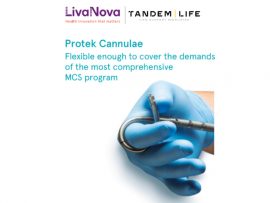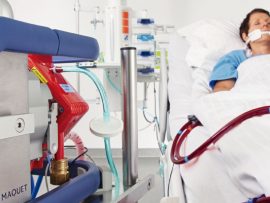Abstract Background Venoarterial extracorporeal membrane oxygenation (V-A ECMO) with femoral access has gained wide acceptance in the treatment of critically ill patients. Since the patient´s cardiac output (CO) can compete..
Read MoreAbstract Background Patients with cardiogenic shock or cardiac arrest undergoing venoarterial extracorporeal membrane oxygenation (V-A ECMO) frequently present with blood glucose levels out of normal range. The clinical relevance of..
Read MoreAbstract Aims Venoarterial extracorporeal membrane oxygenation (VA-ECMO) is increasingly being used to support patients in cardiogenic shock (CS). Early determination of disposition is paramount, as longer durations of support have..
Read MoreAbstract Background: Initiation of veno-arterial (VA) Extracorporeal Membrane Oxygenator (ECMO) is associated with severe complications. It is unknown whether these adverse consequences occur more often after initiations during out of..
Read MoreAbstract Background and Objectives: Cardiogenic shock (CS) is a medical emergency associated with a high mortality rate. Veno-arterial extracorporeal membrane oxygenation (VA-ECMO) has become an accepted therapy for CS. Despite..
Read MoreAbstract Background: With the rapid development of mechanical circulatory support technologies, patients presenting with cardiogenic shock have gained access to various treatment opportunities which were not until recently available. The Impella®..
Read MoreAbstract Importance The optimal approach to the use of venoarterial extracorporeal membrane oxygenation (ECMO) during cardiogenic shock is uncertain. Objective To determine whether early use of moderate hypothermia (33-34 °C) compared with..
Read MoreAbstract Introduction Propofol infusion syndrome (PRIS) is a rare entity that could lead to profound cardiogenic shock (CS). Mitochondrial toxicity and sympathetic blockade are the mechanisms leading to CS in..
Read MoreThe ELSO Interim Guidelines for venoarterial extracorporeal membrane oxygenation (VA ECMO) is timely. I would like to raise a few points on weaning recommendations. First, the parameters detailed in Figure 11..
Read MoreAbstract The Impella CP (Abiomed Inc., Danvers, MA) is widely used in cardiac catheterization laboratories for patients presenting with cardiogenic shock, but it is also known to cause significant hemolysis. The risk..
Read MoreAbstract Extracorporeal membrane oxygenator (ECMO) is effective for maintaining oxygenation and hemodynamic support in patients with post-cardiotomy cardiogenic shock (PCCS). Researchers, led by Ahmed Abdeljawad, sought to compare the effect..
Read MoreAbstract Background Report the incidence and results of peri-operative extracorporeal membrane oxygenation (ECMO) and intra-aortic balloon pump (IABP) of patients undergoing mitral valve surgery (MVS) through right mini-thoracotomy (RT) and..
Read MoreAbstract Temporary mechanical circulatory support can be delivered through a variety of techniques, including percutaneous left ventricular assist devices, surgically implanted rotary pumps, and veno-arterial extracorporeal membrane oxygenation. However, limitations..
Read MoreAbstract Venoarterial extracorporeal membrane oxygenation (VA-ECMO) is a bridging therapy for refractory cardiogenic shock, and limb ischemia is a concern with femoral cannulation. Because of the rich collateral pelvic circulatory..
Read MoreAbstract Postinfarct ventricular septal defect (PIVSD) is associated with high mortality and the management of these patients has been a challenge with little improvement in outcomes. We commenced a protocol..
Read MoreAbstract Background: Little data is published describing the use of medications prescribed for pulmonary arterial hypertension (PAH) in patients receiving extracorporeal membrane oxygenation (ECMO). Even though many patients with PAH..
Read MoreAbstract Introduction Peripheral veno-arterial extracorporeal membrane oxygenation (VA ECMO) creates a retrograde flow along the aorta competing with the left ventricle (LV) in the so-called ‘mixing zone’ (MZ). Detecting it..
Read MoreAbstract The Impella mechanical circulatory support (MCS) system is a catheter-based continuous flow cardiac assist device that is widely used in the treatment of cardiogenic shock in medical and surgical cardiac intensive..
Read MoreAbstract Although acute right ventricular (RV) failure is uncommon, it is associated with a poor prognosis and high mortality. A range of devices now exist to provide temporary mechanical circulatory..
Read MoreAbstract Secondary mitral valve regurgitation is a frequent consequence of left ventricular dysfunction in patients with severe heart failure. The management of this disease can be challenging since it often..
Read MoreAbstract There are quarter of a million articles in PubMed since the wake of the COVID-19 pandemic with about fifteen hundred articles on extracorporeal membrane oxygenation (ECMO) alone. Those that are entrenched..
Read MoreAbstract Background Venoarterial extracorporeal membrane oxygenation (ECMO) provides mechanical support for critically ill patients with cardiogenic shock. Typically, the size of the arterial return cannula is chosen to maximize flow...
Read MoreAcute respiratory distress syndrome (ARDS) encountered during the course of cardiothoracic (CT) surgery is a rare (1.1% incidence) unfortunate event increasing both morbidity and mortality., Cardiogenic shock occurring during CT..
Read MoreAbstract Importance The optimal approach to the use of venoarterial extracorporeal membrane oxygenation (ECMO) during cardiogenic shock is uncertain. Objective To determine whether early use of moderate hypothermia (33-34 °C) compared with..
Read MoreAbstract Introduction Peripheral veno-arterial extracorporeal membrane oxygenation (VA ECMO) creates a retrograde flow along the aorta competing with the left ventricle (LV) in the so-called ‘mixing zone’ (MZ). Detecting it..
Read MoreAbstract Prognostic significance of elevated serum lactate in patients on venoarterial extracorporeal membrane oxygenation (ECMO) is widely known. Our objective was to study the utility of lactate measured at different points of..
Read MoreAbstract Purpose Percutaneous cannulation is increasingly used for veno-arterial extracorporeal membrane oxygenation (VA-ECMO). However, there is limited evidence about the benefit of this approach compared with conventional surgical cannulation. By..
Read MoreAbstract Veno-arterial extracorporeal membrane oxygenation (VA-ECMO) is used as mechanical circulatory support in cardiogenic shock (CS). It restores peripheral perfusion, at the expense of increased left ventricle (LV) afterload. In..
Read MoreAbstract Background. Temporary extracorporeal membrane oxygenation (ECMO) support for high-risk percutaneous coronary intervention (PCI) has been described in select patients, and data are limited on the CardioHELP device (Maquet). The..
Read MoreAbstract Background:Patients with cardiogenic shock due to acute myocardial infarction (AMI) can rapidly undergo veno-arterial extracorporeal membrane oxygenation (VA-ECMO) therapy to recover cardiac output and decrease mortality. However, the clinical..
Read More



















